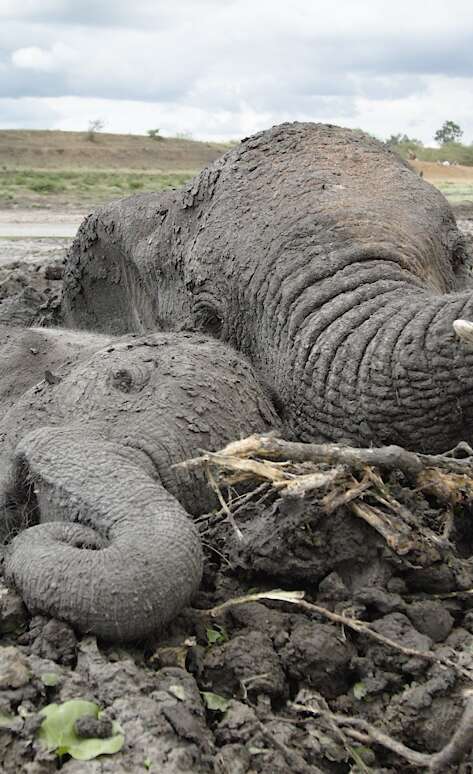The drought in Kenya in 2022 was merciless. Rivers shrank into dust, watering holes turned into pits of sludge, and wildlife fought desperately for survival. Among those searching for relief was a mother elephant and her 5-month-old calf, who trailed faithfully at her side. Weary and thirsty, they stumbled upon what looked like salvation—a shallow pool that promised water.

But it was no pool. It was a trap.
The surface that shimmered like hope was in fact a dense field of mud. The mother, enormous and heavy, lost her footing. With each frantic movement, she sank deeper, her strength working against her. Beside her, her baby calf slipped in too, bleating in confusion as the mud clung to his small frame.
For two days, the pair fought the mire. Under the blistering sun, the mother thrashed until she had no strength left. She could do nothing more than pull her calf close, wrapping her trunk protectively around his body, shielding him from a world she could no longer fight. Hungry, dehydrated, and weak, the calf pressed into her side. If this was to be their end, they would face it together.
Help arrived just in time.

The Sheldrick Wildlife Trust, alerted by the Kenya Wildlife Service and Wildlife Works, knew this remote site all too well—they had just rescued other elephants from the very same trap days before. Racing against time, the SWT rescue team and veterinarians assessed the scene. The mother’s eyes were wild with terror, her body wasted from dehydration. Every attempt to reach the calf was met with her fierce defiance. She swung her trunk, blocking any rescuer who dared to come near.
Even as the mud pulled her down, she would not surrender her baby.
Finally, the vets made the only choice possible: they gently anesthetized the mother. She slumped, still, but safe. It was the only way to free the calf without injury. With her subdued, the team pulled the little one from the muck. Yet freedom was not what he wanted. The calf bolted back to his unconscious mother, crying desperately, refusing to be parted from her side.
The vets, hearts aching at the calf’s loyalty, gave him a mild anesthetic too. Only then could the digging continue. With ropes, shovels, and sheer will, the team worked for hours. Three vehicles—a tractor and two land cruisers—were harnessed to the mother’s massive frame. Inch by inch, they hauled her free.
And then, at last, victory.

Both mother and calf were safe, battered but alive. Fluids were given, mud was scraped away, and when the baby stirred awake, he wasted no time. His small trunk reached for her, nudging, pleading. Slowly, heavily, the mother stirred. She blinked, raised her head, and felt her calf pressing against her. Together, they rose.
The rescuers watched in awe as the calf, still unsteady, took the lead. Step by step, he guided his mother away from the deadly pit, as though to say, This time, I will protect you. Mud still clung to their hides, but with each step, they left behind despair and reclaimed freedom.
That day, the Sheldrick Wildlife Trust not only saved two elephants—they bore witness to a story as old as time. A mother who would risk everything to protect her young. A calf who could not imagine a world without her. A bond so strong that even hunger, exhaustion, and death could not break it.

Inspired by their ordeal, SWT worked with local leaders to transform the treacherous pit into a safer dam, ensuring it could serve both the community and the wildlife that depended on it.
But for those who stood in the mud that day, watching the mother and her calf disappear into the horizon, the greatest lesson was not about water, or danger, or even rescue. It was about love.

A mother’s love that would not yield.
A calf’s devotion that would not let go.
And the reminder that in the wild, as in life, the bond between parent and child is the strongest force of all.




